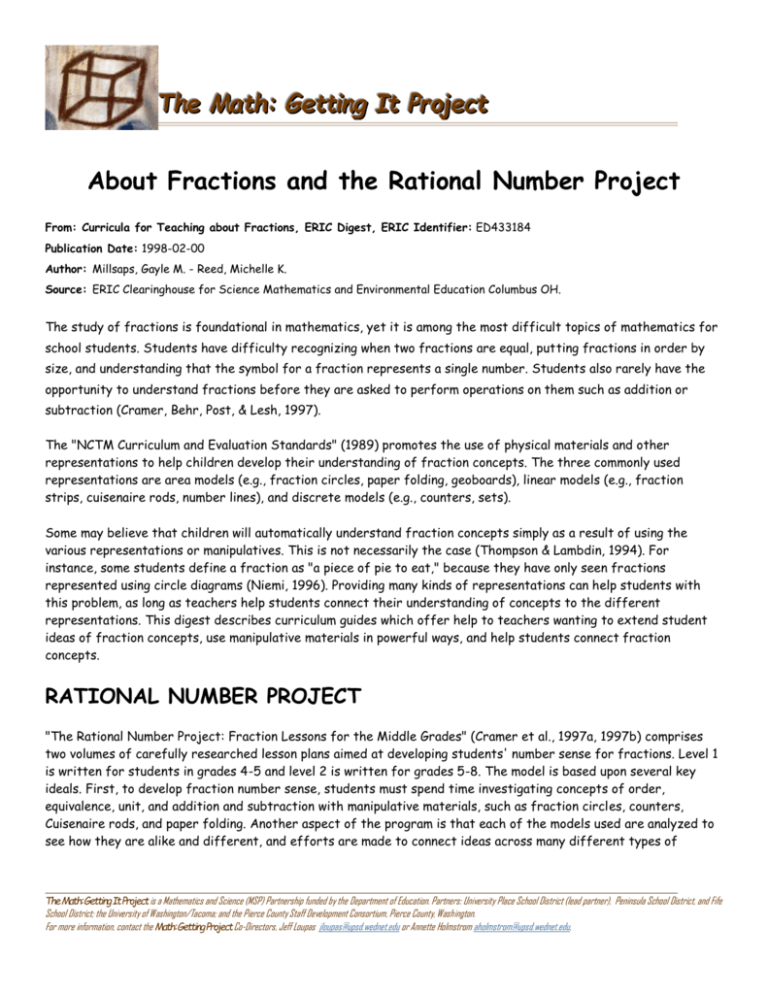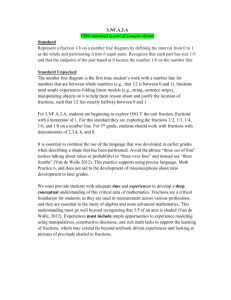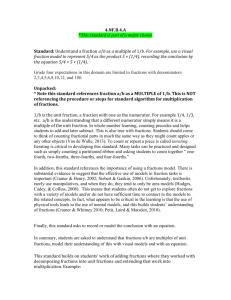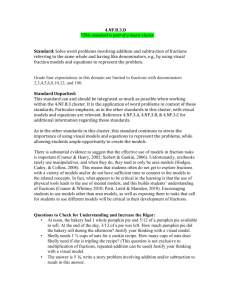summary of the Rational Number Project
advertisement

The Math: Getting It Project About Fractions and the Rational Number Project From: Curricula for Teaching about Fractions, ERIC Digest, ERIC Identifier: ED433184 Publication Date: 1998-02-00 Author: Millsaps, Gayle M. - Reed, Michelle K. Source: ERIC Clearinghouse for Science Mathematics and Environmental Education Columbus OH. The study of fractions is foundational in mathematics, yet it is among the most difficult topics of mathematics for school students. Students have difficulty recognizing when two fractions are equal, putting fractions in order by size, and understanding that the symbol for a fraction represents a single number. Students also rarely have the opportunity to understand fractions before they are asked to perform operations on them such as addition or subtraction (Cramer, Behr, Post, & Lesh, 1997). The "NCTM Curriculum and Evaluation Standards" (1989) promotes the use of physical materials and other representations to help children develop their understanding of fraction concepts. The three commonly used representations are area models (e.g., fraction circles, paper folding, geoboards), linear models (e.g., fraction strips, cuisenaire rods, number lines), and discrete models (e.g., counters, sets). Some may believe that children will automatically understand fraction concepts simply as a result of using the various representations or manipulatives. This is not necessarily the case (Thompson & Lambdin, 1994). For instance, some students define a fraction as "a piece of pie to eat," because they have only seen fractions represented using circle diagrams (Niemi, 1996). Providing many kinds of representations can help students with this problem, as long as teachers help students connect their understanding of concepts to the different representations. This digest describes curriculum guides which offer help to teachers wanting to extend student ideas of fraction concepts, use manipulative materials in powerful ways, and help students connect fraction concepts. RATIONAL NUMBER PROJECT "The Rational Number Project: Fraction Lessons for the Middle Grades" (Cramer et al., 1997a, 1997b) comprises two volumes of carefully researched lesson plans aimed at developing students' number sense for fractions. Level 1 is written for students in grades 4-5 and level 2 is written for grades 5-8. The model is based upon several key ideals. First, to develop fraction number sense, students must spend time investigating concepts of order, equivalence, unit, and addition and subtraction with manipulative materials, such as fraction circles, counters, Cuisenaire rods, and paper folding. Another aspect of the program is that each of the models used are analyzed to see how they are alike and different, and efforts are made to connect ideas across many different types of The Math: Getting It Project is a Mathematics and Science (MSP) Partnership funded by the Department of Education. Partners: University Place School District (lead partner), Peninsula School District, and Fife School District; the University of Washington/Tacoma; and the Pierce County Staff Development Consortium, Pierce County, Washington. For more information, contact the Math:Getting Project Co-Directors, Jeff Loupas jloupas@upsd.wednet.edu or Annette Holmstrom aholmstrom@upsd.wednet.edu, The Math: Getting It Project representations. This practice corresponds to the Lesh Translation Model (see Cramer, Behr, Post, & Lesh, 1997a or b). Both level 1 and level 2 lessons emphasize developing the meaning for fraction symbols before asking students to operate on them. Except for the topic of multiplication of fractions and the introduction of a new, more complex model for fractions (Cuisenaire rods) in level 2 lessons , both sets of lessons cover the same topics. Initial lessons in level 1 have students engage in modeling and naming (verbally and symbolically) fractions less than 1 using area models such as fraction circles, paper strips, and other shapes. Throughout these initial lessons the concept of the flexibility of the unit is developed by using a variety of non-standard shapes to represent one whole such as half of a circle. Fraction equivalence and ordering are then introduced using area models before students are asked to develop the same concepts using a discrete model such as counters. The next tier of lessons returns to the initial area models of fractions to develop students' ability to reconstruct the whole given a fractional part and to model and name fractions greater than 1. A subsequent lesson extends the concept of fraction equivalence using the rate series by having students look for number patterns in the information they have already gathered about equivalent fractions. In the closing lessons, addition, subtraction, and multiplication (level 2 only) are introduced via students' modeling of stories. A special emphasis is given to students' estimation of the sums, differences or products by recognizing the approximate size of the fraction operands using their internalized visual models of fractions. SUMMARY The key features of the curriculum materials described here are implicit in the Lesh Translation Model presented above. Students begin to construct a deeper understanding of fractions when they are represented in a variety of ways and when there are explicit linkages to everyday life and familiar situations involving the use of fractions. Other resources that facilitate these linkages are grouped here by topic. BEGINNING FRACTION CONCEPTS Leutzinger, L. P., & Nelson, G. (1980). Let's do it: Fractions with models. 'Arithmetic Teacher," 27(9), 6-11. Presents beginning fraction concepts using a circle-region or "pie" model. McBride, J. W., & Lamb, C. E. (1986). Using concrete materials to teach basic fraction concepts. "School Science and Mathematics," 86(6), 480-488. Describes how to prepare inexpensive materials. Van de Walle, J., & Thompson, C. S. (1984). Let's do it: Fractions with fraction strips. "Arithmetic Teacher," 32(4), 4-9. Describes how to make fraction strips and presents beginning activities. The Math: Getting It Project is a Mathematics and Science (MSP) Partnership funded by the Department of Education. Partners: University Place School District (lead partner), Peninsula School District, and Fife School District; the University of Washington/Tacoma; and the Pierce County Staff Development Consortium, Pierce County, Washington. For more information, contact the Math:Getting Project Co-Directors, Jeff Loupas jloupas@upsd.wednet.edu or Annette Holmstrom aholmstrom@upsd.wednet.edu, The Math: Getting It Project MULTIPLICATION OF FRACTIONS Sinicrope, R., & Mick, H. W. (1992.) Multiplication of fractions through paper folding. "Arithmetic Teacher," 40(2), 116121. Uses an area model to show multiplication of fractions. Cramer, K., & Bezuk, N. (1991). Multiplication of fractions: Teaching for understanding. "Arithmetic Teacher," 39(3), 34-37. Uses geoboards, paper folding, and counters to show multiplication of fractions concepts. DIVISION OF FRACTIONS Curcio, F. R., Sicklick, F., & Turkel, S. B. (1987). Divide and conquer: Unit strips to the rescue. "Arithmetic Teacher," 35(4), 6-12. Uses teacher-made strips to show division ideas. REFERENCES Corwin, R. B., Russell, S. J., Tierney, C. C. (1990). "Seeing fractions: A unit for the upper elementary grades." Sacramento, CA: California Dept. of Education. (ED 348 211). Cramer, K., Behr, M., Post, T., & Lesh, R. (1997a). "Rational Number Project: Fraction Lessons for the Middle Grades: Level 1." Dubuque, IA: Kendall/Hunt Publishing. Cramer, K., Behr, M., Post, T., & Lesh, R. (1997b). "Rational Number Project: Fraction Lessons for the Middle Grades: Level 2." Dubuque, IA: Kendall/Hunt Publishing. Curcio, F. R., & Bezuk, N. S. (1994). "Understanding rational numbers and proportions." Reston, VA: NCTM. (ED 373 991) NCTM. (1989). "Curriculum and evaluation standards for school mathematics." Reston, VA: Author. Niemi, D. (1996). A fraction is not a piece of pie: assessing exceptional performance and deep understanding in elementary school mathematics. "Gifted Child Quarterly," 40, 70-80. Thompson, P. W., & Lambdin, D. (1994). Research into practice: Concrete materials and teaching for mathematical understanding. "Arithmetic Teacher," 41(9), 556-558. The Math: Getting It Project is a Mathematics and Science (MSP) Partnership funded by the Department of Education. Partners: University Place School District (lead partner), Peninsula School District, and Fife School District; the University of Washington/Tacoma; and the Pierce County Staff Development Consortium, Pierce County, Washington. For more information, contact the Math:Getting Project Co-Directors, Jeff Loupas jloupas@upsd.wednet.edu or Annette Holmstrom aholmstrom@upsd.wednet.edu,








